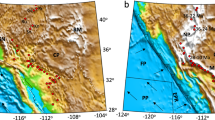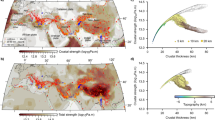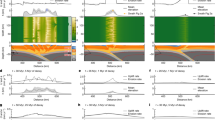Abstract
MOST mountain belts occur where continents collide, so it is not surprising that the dominant form of surface deformation is shortening. But there is also abundant geological evidence for extension in the central parts of many mountain belts, at the same time as shortening occurs elsewhere. Previous models for extension require temporal changes in the thermal structure of the lithosphere1,2 the rate of convergence2,3 the strength of the crust3 or the geometry of accretion4. Here we present a simple model in which no such changes are required for surface extension during the convergent thickening of a viscous 'crusta' layer. Convergence is driven by the motion of two plates at the base of the layer. In the area where one plate 'Subducts' under the other, the surface begins to extend soon after the start of convergence, eventually stretching by more than 60 per cent. Extension occurs because gravity drives horizontal flow faster at the free surface than in the centre of a viscous layer that is fixed at its base. In real mountain belts, mid-crustal weaknesses may allow the depth-dependent motion required for surface extension.
This is a preview of subscription content, access via your institution
Access options
Subscribe to this journal
Receive 51 print issues and online access
$199.00 per year
only $3.90 per issue
Buy this article
- Purchase on Springer Link
- Instant access to full article PDF
Prices may be subject to local taxes which are calculated during checkout
Similar content being viewed by others
References
Dewey, J. F. Tectonics 7, 1123–1139 (1988).
England, P. C. & Molnar, P. in Himalayan Tectonics (eds Trelor, P. J. & Searle, M. P.) 401–411 (Spec. Publ. No. 74, Geol. Soc, London, 1993).
Willett, S., Beaumont, C. & Fullsack, P. Geology 21, 371–374 (1993).
Platt, J. P. Geol. Soc. Am. Bull. 97, 1037–1053 (1986).
Selverstone, J. Tectonics 7, 87–105 (1988).
Burg, J. P., Brunel, M., Gapais, D., Chen, G. M. & Liu, G. H. J. struct. Geol. 6, 535–542 (1984).
Burchfiel, B. C. & Royden, L. H. Geology 13, 679–682 (1985).
Anderson, H. & Jackson, J. Geophys. J. R. astr. Soc. 91, 937–983 (1987).
Royden, L. H., Patacca, E. & Scandone, P. Geology 15, 714–717 (1987).
Arnaud, N. O., Brunel, M., Cantagrel, J. M. & Tapponier, P. Tectonics 12, 1335–1346 (1993).
Solomon, S. C. et al. Science 252, 297–312 (1991).
Molnar, P. & Gray, D. Geology 7, 58–62 (1979).
Brace, W. F. & Kohlstedt, D. L. J. geophys. Res. 85, 6248–6252 (1981).
Dixon, J. M. & Summers, J. M. J. struct. Geol. 7, 83–102 (1985).
Turcotte, D. L. & Schubert, G. Geodynamics (Wiley, New York, 1982).
England, P. C. & McKenzie, D. P. Geophys. J. R. astr. Soc. 70, 295–321 (1982).
Byrne, D. E., Wang, W.-h. & Davis, D. M. Tectonics 12, 123–144 (1993).
Author information
Authors and Affiliations
Rights and permissions
About this article
Cite this article
Buck, W., Sokoutis, D. Analogue model of gravitational collapse and surface extension during continental convergence. Nature 369, 737–740 (1994). https://doi.org/10.1038/369737a0
Received:
Accepted:
Issue Date:
DOI: https://doi.org/10.1038/369737a0
Comments
By submitting a comment you agree to abide by our Terms and Community Guidelines. If you find something abusive or that does not comply with our terms or guidelines please flag it as inappropriate.



